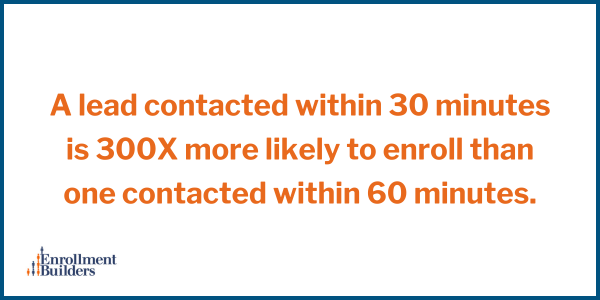Are you frustrated with your admissions yield rate? Do you find it challenging to increase your...
Higher Education Enrollment Management Strategies for 2025
Are you feeling pressure about not hitting your enrollment goals this year? Have you exhausted all your ideas to improve your admissions strategies and processes?
At Enrollment Builders, we hear these struggles from admissions leaders on a regular basis. We've compiled a list of enrollment management best practices to help you take back control and improve your enrollment.
In this article, you’ll discover six key enrollment management strategies higher ed institutions should use to improve recruitment efforts and increase student enrollment:
- Analyze your current admissions funnel performance
- Audit and optimize your admissions outreach to new student inquiries
- Invest in professional development for your admissions staff
- Implement a strategy to re-engage previous leads
- Proactively address common barriers to enrollment
- Incorporate AI into your enrollment management strategy
By the end of the article, you’ll know which admissions strategies to prioritize first to make the biggest improvement on your admissions performance.
1. Analyze Your Current Admissions Funnel Performance
Before implementing new enrollment strategies, it's essential to analyze your current admissions funnel performance. This involves examining the various stages of the admissions process—from initial inquiry to enrollment—and prioritizing the biggest opportunities first.
Once you understand your current performance, you can compare it to industry benchmarks to identify areas where you fall short or exceed expectations.
For example, if your Inquiry-to-Application Rate is lower than the benchmark, it may indicate that your initial outreach efforts need improvement.
On the other hand, if your Admissions-to-Enrollment Rate is falling short, you should focus on strategies related to that area of your admissions process.
Actions to Take When Analyzing Your Admissions Funnel
- Identify Key Metrics to Monitor: Start by choosing what KPIs you want to review and regularly monitor. Focus on metrics that provide insights into each stage of the admissions funnel, such as Inquiry to Application Rate, Application to Admission Rate, and Admissions to Enrollment Rate.
- Compare Your Funnel Performance to Industry Benchmarks: Once you have a baseline of how your current funnel is performing, you’ll want to compare it to your competitors. This can help you develop realistic goals you can work towards as you optimize your enrollment management strategies.
- Invest in Enrollment Management Software: Many institutions leverage enrollment management tools to streamline data collection and analysis.
- Hire an Enrollment Management Partner: Not every institution has the resources to ask someone on staff to build data models, analyze information, and make recommendations based on the data. If that’s the case for you, consider partnering with experts who can provide valuable analysis and insights based on your data.
Don’t know which metrics to analyze? Wonder what the industry standard is for each one? Download the free Admissions Funnel Guide to discover how your conversion rates stack up.
2. Audit and Optimize Your Admissions Outreach to New Inquiries
A common trait among admissions processes is the primary focus on emailing prospective students. However, these students have changed over the years, and so have their preferred communication methods with institutions like yours.
For the highest chance of success, your enrollment strategy should include multiple contact methods that work together. The most common methods we recommend include phone, text, voicemail, website chat, and email.

Additionally, according to an MIT Study, a lead contacted in the first 30 minutes is 300 times more likely to enroll than someone contacted within 60 minutes. Since many prospective students inquire online about multiple colleges at once, quick, effective communication is crucial to maintaining their interest and guiding them through your admissions process.
Because of these factors, auditing and optimizing your admissions outreach is one of the most impactful ways to increase your Inquiry to Application Rate!
Actions to Take When Optimizing Your Admissions Outreach Strategies
- Request a Free Admissions Outreach Audit: If you don’t know the current state of your admissions outreach, click here to request a free audit and gain insights into your outreach efforts to new student inquiries.
- Implement Automated Emails: Set up an automated email response for every Request for Information (RFI) form on your website to ensure no lead is left waiting for a next step.
- Set Up Real-Time Lead Distribution: Configure your CRM so your admissions counselors receive new leads in real-time for immediate follow-up via phone during office hours. Common platforms admissions teams use for this include Element451, Slate, and Salesforce.
- Add Texting as a Communication Method: At Enrollment Builders, when working with high school populations, we successfully “earn” a call by first sending a series of texts. If you want to grow traditional enrollments, including text messaging within your communications is a must!
- Hire a Contact Center Partner: If you’re unsure whether your existing team has the bandwidth to implement automated processes or contact every new lead quickly enough, hire an admissions contact center partner to optimize and execute outreach strategy.
3. Invest In Professional Development for Your Admissions Staff
Continuous professional development is essential to keep your admissions team informed about enrollment management trends and best practices.
Professional development helps your team stay updated with industry changes, improves their skills, and enhances their ability to effectively engage with prospective students.
Actions to Take to Improve Professional Development for Your Staff
- Attend Conferences: Send your team to an admissions or enrollment management conference to learn from their peers in a way they aren’t usually able to. Need ideas on a conference to choose from? Dive into this list of popular events: Your Guide to Higher Ed Admissions & Enrollment Management Conferences
- Participate in Online Workshops and Webinars: If in-person conferences aren’t within your budget or schedule, consider looking into online workshops or webinars offered by enrollment management leaders like AACRAO.
- Conduct Internal Training: Organize regular training sessions and knowledge-sharing meetings with your team. These could cover topics such as new initiatives you will implement, reviewing best practices and processes, or collaborating on strategies with the marketing team.
4. Implement a Strategy to Re-Engage Previous Leads
At Enrollment Builders, we’ve found that many institutions not only need more leads - they also need to better mine the potential within the list of prospective students they already have.
One of the best ways to do this is by engaging with your aged prospects and inquiries. Aged leads are prospective students in your funnel who have exhausted all of your previous outreach attempts. As a leader, you probably aren’t sure what type of outreach these leads consistently received in the past. They may have lower contact and engagement rates when you reach out to them. The combination of these factors typically results in teams writing off these leads as "dead leads."
However, a prospective student may still be a valid lead for several reasons. In many cases, they just may not have been ready when you were. This is especially true for adult and nontraditional learners - life happens, and a prospective student’s initial plans or timelines may have changed.
If you build a strategy and a process to re-engage old inquiries, you can qualify those still interested and move them further in the admissions process.
Actions for Implementing a Lead Re-Engagement Strategy
- Set Up Lead Scoring: If you have thousands of aged leads and don’t know how to prioritize them, use lead scoring to segment and re-engage the most valuable aged leads in your list.
- Implement Targeted Campaigns: After prioritizing the aged leads, you want to connect with them and encourage them to respond. This involves creating targeted campaigns based on specific criteria, such as when the lead last engaged with you or the type of program they are interested in.
- Outsource Lead Re-Engagement to an Admissions Partner: If your team has bandwidth challenges and you want them to focus on contacting new leads, hiring an outsourced admissions partner to execute specific aged lead campaigns can be an excellent way to supplement your current efforts.
For more detailed information on how to implement an aged lead re-engagement strategy, read the full article: How to Increase Student Enrollment by Working Aged Leads
5. Proactively Address Common Barriers to Enrollment
Prospective students often face several barriers that can prevent them from enrolling in your institution. Understanding and addressing these concerns proactively can significantly improve your enrollment rates.
By alleviating these concerns, you can create a smoother and more reassuring experience for potential students, making it easier for them to confidently choose your institution.
The four most common concerns prospective students have are:
- Time - “I don’t know how I would fit school into my schedule.”
- Money - “I can’t afford to pay for school right now.”
- Value - “How is your degree ranked in my profession?”
- Ability - “I’m not good at math and don’t feel comfortable taking it online.”
The priority order of addressing these concerns may vary depending on whether you are communicating with traditional or adult/non-traditional students and which programs you focus on. Be sure to reflect on recent admissions conversations to identify the most prevalent concerns with your institution’s prospective students.
Actions for Proactively Addressing Student Concerns
- Provide Internal Resources for Admissions Counselors: Your team deserves to have a clear path of options that allows them to lead your leads down a clear path as they consider your institution. Give them what they need to lead a tailored admissions process. Start by downloading this free Admissions Counselor’s Conversation Guide to share with your team!
- Create Resources for Prospective Students: Develop various materials that address common questions and concerns. This can include FAQs, video testimonials, webinars, and detailed guides.
- Include Resources in Early Communications: Include links to these resources in your initial emails to prospective students. This ensures they can access the information they need right from the start.
- Offer Office Hours or Virtual Meetings: Provide opportunities for prospective students to discuss their concerns directly with your team. This could be through virtual meetings, webinars, or dedicated office hours focused on these topics.
6. Incorporate AI Into Your Enrollment Management Strategy
Leveraging technology can provide a significant competitive edge in the evolving landscape of higher education. Artificial Intelligence (AI) is transforming various industries, and enrollment management is no exception.
Incorporating AI into your enrollment management strategy can enhance your recruitment efforts, streamline processes, offer valuable insights, and provide personalized experiences for prospective students.
Actions to Effectively Incorporate AI Into Your Enrollment Strategies
- Automate Repetitive Tasks: Free up your team’s time to focus on strategic initiatives by automating tasks such as data entry and follow-up communications.
- Personalize Communications: Leverage AI-driven tools to analyze lead data and customize communication based on individual preferences and behaviors. Specifically tailored messages can help increase student engagement and interest.
- Enhance Data Analysis: Utilize AI to analyze application and enrollment data, identify patterns, and predict future trends. This can help you make data-driven decisions, optimize recruitment strategies, and allocate resources more effectively.
Set Your Admissions Team Up for Enrollment Management Success
As an admissions leader, you hold the key to your institution’s enrollment success. And now, you’ve explored a range of enrollment management strategies, from analyzing your current admissions funnel to incorporating AI.
With these strategies, you are better positioned to take actionable steps toward boosting your new student enrollment. By committing to implementing them, you’re not only improving your current enrollment processes and strategies - you’re setting the stage for sustainable growth in the future.
However, when your team is already stretched thin, knowing what strategy to implement and finding the bandwidth to do so effectively can feel overwhelming. When facing these challenges, admissions leaders like you consider outsourcing part of their admissions process so their team can focus on connecting with the most qualified prospective students.
Higher education enrollment leaders partner with Enrollment Builders to turn more prospective students into qualified applicants. If you’re frustrated with your current admissions performance, we’re here to help. We aim to get to the root of your enrollment problems and find the right balance of support your admissions team needs.
Click below to schedule your call and start optimizing your enrollment management strategies:




